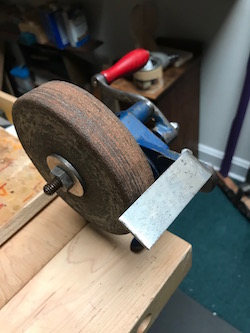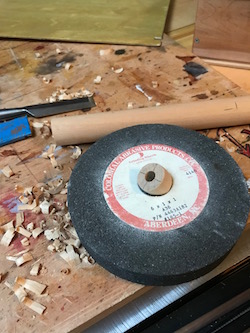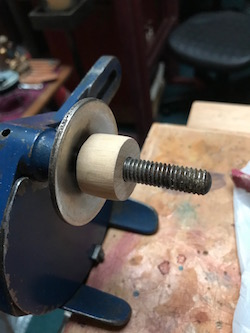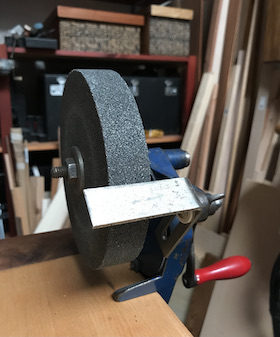Old bench grinders don’t have a lot of fans for a few reasons. They were a staple in many workshops until the efficient “look ma, no hand crank” electric grinders sounded that familiar death knell.
I love visiting flea markets, antique stores, and barns to look for old tools. It’s a fun thing to do on a weekend or while on vacation. Sometimes, if I spot a flea market while I am on a road trip, I’ll stop. Most times, I plan special trips to visit flea markets many miles from home.
I have a mental list of things I want for my hand tool woodshop. It’s such a pleasant surprise when a wish list item magically appears before my eyes. Of course, the real fun begins when haggling for a good price and feeling that I have a great item!
An important part of looking for tools like old bench grinders is having a good eye for evaluating them. This is true for any item, whether it is a tool or not.
It is best to avoid items that are:
- frozen from impacted, dried grease or encrusted rust – especially on handles
- covered in mold or worse
- broken or so badly damaged and thus unsafe
- wobbly or unstable
- in need of parts no longer manufactured
Still, I wanted an old school, hand-cranked bench grinder for my small space.
I found this one:

This old hand-cranked bench grinder was in decent shape. As you know, I have no interest in handling extremely rusty tools. A little dirt is to be expected and is acceptable. I always bring gloves when I’m on the hunt. Some tools, however, are so far gone that they are not worth the time to clean them up.
No amount of dressing could help the old wheel. I needed a replacement. Little did I know that they, too, are not readily available. So guess what? Another quest to find a grinding wheel to fit, that’s what.

I found a NOS (new old stock) coarse grinding wheel. It was difficult enough finding the wheel. Now, I needed a bushing to reduce the arbor hole from 1″ to 3/8″. That very small, very elusive part was not to be found, so I made one from a 1-1/4″ diameter maple dowel.
First, I drilled a 3/8″ hole in the bushing cut from the dowel to fit the main stem. Then, I had to make small adjustments by trimming the wood bushing so that it finally fit the arbor hole.

You Ain’t Gonna See it Til You Need it
After cleanup, the addition of the wood bushing and a drop of oil, the bench grinder works perfectly.
Click on the video to see the old grinder in action with the coarse wheel:
It’s almost perfect for a flea market find. And there’s no noticeable wobble.
Here is another video of the same old grinder with a fine grit wheel:
Looking for parts to complete a flea market find requires patience. I found the bench grinder during a trip to Wisconsin. After visiting several flea markets during the following year, I found the grinding wheels.
I really did not think that I would find any, but I found two, the coarse wheel, then the finer wheel.
Sum of the bench grinder parts
Here is the wheel roundup:
Black grinding wheel:
- NOS 6″ x 1″ x1″
- A36 coarse grit black grinding stone
- shop made wood bushing to reduce the arbor hole to 3/8″
White grinding wheel:
- NOS 6″ x 1″ x 1/2″
- A60 Norton fine grit white grinding stone
- found metal 1/2′ to 3/8′ router bushing to reduce the arbor hole
Both wheels work beautifully. After dressing the wheel(s) and balancing the tool rest, they are perfect for putting an initial bevel on my chisels. After that, I can get creative if need be or use my waterstones to attain the level of sharpening required.
I love the speed control and the feeling of safety. Yes, it is slower than the power grinders, but also quieter and I can run it forward or backward. I get a small amount of metal grindings but that’s an easy cleanup.
The best features of the old school grinder – the old hand-crank variety – is the easy set up and tiny footprint. I can bring it out, use it, and put it away with little effort. It is just right for me and fits perfectly in my shop.
Challenges to Restoring Old Tools
I did look at new grinding wheels but today’s manufacturing focus is primarily on new electric bench grinders. Even companies like Norton, devote their resources to those devices. The new wheels are expensive and are not really compatible with the old school grinders (bushings, again). Since I had to figure out what I was looking for, I did not want a wrong choice to cost me in wasted time and money.
The best way to possibly find a replacement wheel is from a supply of NOS. This unused inventory is oftentimes recovered from old hardware stores that have closed or gone out of business.
The items may be dusty or a little dirty from being on the shelf and from occasional handling, but they still work.
I was lucky to find wheels at the flea market, but estate sales, online resources, and of course, friends, may prove fruitful. Keep your eyes open for leads.
Good hunting, toolies!
💙 -Shirley J

